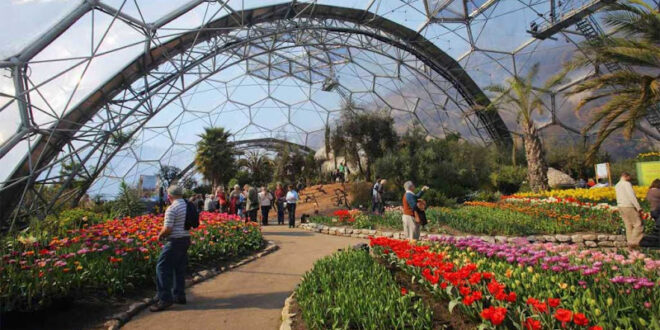Introduction
ETFE membranes, first of all, developed for aerospace use, are revolutionizing architecture and landscaping. In urban environments, gardening areas are essential in enhancing aesthetics and combating pollution.
However, demanding situations like limited space and vicious climates restrict their potential. ETFE membranes offer a solution with their transparency, durability, and versatility. They create controlled environments, optimizing natural light and shielding plants from adverse weather.
This article explores how ETFE membranes redefine urban gardening, maximizing green spaces’ impact and sustainability in cities. Join us as we unveil the transformative power of ETFE membranes in enriching city landscapes for a greener future.
Understanding ETFE Membranes
ETFE (Ethylene Tetrafluoroethylene) membranes are advanced polymer materials recognized for their transparency, durability, and versatility.
These lightweight, translucent membranes allow natural light to penetrate while offering outstanding power and resistance to weathering and UV radiation. Their flexibility allows architects to create dynamic, innovative structures that respond to environmental situations.
Examples of their utilization include the iconic biomes of the Eden Project in the UK, the color-changing façade of the Allianz Arena in Germany, and the transparent bubble-like structure of the Water Cube in China.
These structures highlight ETFE membranes’ ability to enhance aesthetics and functionality in architectural design.
Challenges in Urban Gardening
Urban gardening faces limited space, pollution, and weather fluctuations. In cities, space constraints lead to smaller lawn areas or vertical gardening techniques. Pollution from urban activities threatens plant health and human well-being. Climate variability, including extreme temperatures and irregular rainfall, affects plant growth.
Addressing these demanding situations requires innovative solutions for sustainable urban environments. Urban gardening provides fresh produce and enhances biodiversity and air quality, promoting community well-being.
Sustainable practices like rooftop gardens and hydroponics mitigate space limitations and pollution while fostering environmental resilience. Collaborative efforts among stakeholders are essential for creating thriving urban gardens amid urbanization pressures.
Case Studies
Eden Project, UK:
The Eden Project in the UK is fully covered with ETFE membranes which provide a controlled environment for the different species of plant. These membranes use natural light and provide shelter against adverse weather conditions.
Singapore Changi Airport, Jewel Terminal:
The Jewel Terminal features lush gardens sheltered by ETFE membranes, including the iconic Rain Vortex surrounded by greenery. ETFE membranes allow pure and healthy sunlight, creating a peaceful atmosphere within the bustling airport environment.
National Garden of the Future, Abu Dhabi:
Abu Dhabi’s National Garden of the Future showcases ETFE-covered structures providing shade for both native and non-native plants. The membranes enable innovative designs like canopy walkways, enhancing visitor experiences while promoting sustainability.
Design Considerations
Incorporating ETFE membranes into gardening areas demands meticulous consideration of structural integrity, aesthetics, and sustainability. Structural evaluations must ensure the load-bearing ability of supporting factors, employing robust anchoring systems for balance.
Aesthetic choices involve balancing transparency levels for natural light and integrating colorations or patterns to enhance visual appeal. Harmonizing ETFE systems with surrounding landscape designs ensures cohesive environments.
Sustainability efforts focus on optimizing energy efficiency through natural light penetration and selecting recyclable materials. Architects and landscape designers must collaborate closely with engineers, prioritize functionality, and experiment with innovative forms.
Additionally, incorporating maintenance-friendly ETFE materials and engaging stakeholders throughout the design process ensures a seamless and sustainable integration, yielding vibrant and enduring gardening areas.
Future Trends and Innovations
The future of ETFE membranes in gardening areas guarantees groundbreaking advancements. Anticipate the integration of smart climate control systems for precise environmental regulation, fostering superior plant growth.
Biophilic design principles will incorporate natural elements, enhancing the connection with nature. Interactive capabilities like integrated irrigation and renewable energy technologies will redefine functionality. Material innovations will yield lighter, stronger, and more sustainable membranes with improved durability.
Augmented reality and visualization tools will revolutionize the design process. Envisioned as dynamic, sustainable, and aesthetically pleasing, these developments position ETFE membranes as pivotal components in the evolution of urban gardening, harmonizing technology, and nature for a greener future.
Conclusion
In conclusion, ETFE membranes revolutionize urban gardening by addressing space restrictions, pollution, and climate changes.
These membranes create controlled environments, optimizing plant growth while enhancing aesthetic appeal. With advancements like smart climate control systems and biophilic design integration, ETFE structures offer sustainable solutions for urban green spaces.
As technology evolves, ETFE membranes will continue to redefine gardening, fostering biodiversity and promoting a deeper connection with nature in urban environments.
 Make Home Smart Let's Make Smart Home for Everyone!
Make Home Smart Let's Make Smart Home for Everyone!




